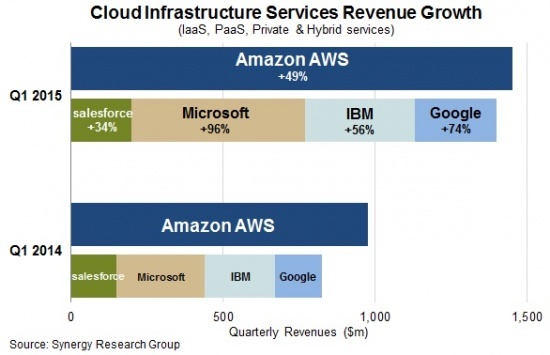What is the most used hypervisor? Xen
 STOP! Stop stop stop. I understand your indignation. I know that you are already ready to shout that I am an incompetent idiot if I wrote this in the headline. The title is indeed provocative, but let's get it right.
STOP! Stop stop stop. I understand your indignation. I know that you are already ready to shout that I am an incompetent idiot if I wrote this in the headline. The title is indeed provocative, but let's get it right. So. What did you want to tell me about? Most of you probably wanted to let me know that VMware is the dominant virtualization system for enterprises. Perhaps someone who is associated with companies whose entire infrastructure is built on Microsoft solutions is ready to convince me that the popularity of Hyper-V is comparable, or even in some cases exceeds VMware. And there are surely those who remember that in telecom, hosting and OpenStack solutions, as a rule, they use KVM.
In other words, it all depends on how you count. If the share of the corporate market (profit), then VMware will be the leader. If by ... let's call it "ecosystem coverage", then Hyper-V, if by growth rate of use, then KVM. But I want to compare the number of virtual machines running on hypervisors. On a global scale, of course.
How to estimate the number of virtual machines worldwide and the IT infrastructure in which they operate? We will proceed from the fact that the largest number of virtual machines is with cloud service providers and turn to the results of market research (2015) of cloud services from Synergy Research Group:
Amazon remained the largest cloud provider, recording a 31% market share in the asset. Following Microsoft and IBM are far behind the leader, having 9- and 7-percent performance, respectively. The top five by the end of 2015 also included Google (4%) and Salesforce (4%).

Please note, Amazon's cloud business is larger than that of Microsoft, IBM, Google and Salesforce.com in total (!!!) . According to a 2014 Gartner estimate, Amazon sold 5 times more computing power than the other 14 companies in the quadrant combined. Moreover, Amazon continues to strengthen its position, increasing its market share, the total volume of which in 2014 amounted to more than $ 17 billion.
Let's go further. What hypervisors do leading cloud providers use? Let's look at the picture (it ’s from this post ):

Of the 15 cloud providers presented on the chart, 4 use Xen, but we are primarily interested in Amazon.
Important Note: In fact, Amazon doesn’t use a specific product like Citrix XenServer or something else, but “its own Xen”, based on code developed by the xenproject.org community .
Of course, the data is not entirely fresh, and many cloud providers use several hypervisors at once in their IT infrastructure, and not all are taken into account. For example, besides Amazon Web Service, the major “users” of Xen-based virtualization are Tencent, Alibaba Cloud, Liquid Web, Verizon Cloud, Linode, SparkNode, OrionVM and Rackspace Cloud. But in this case, exact numbers are not needed.Even rough estimates show that the share of Xen hypervisor usage in cloud computing is ~ 50% (mainly due to AWS), the rest of the market is shared by KVM, Hyper-V and VMware.
Xen developers are very proud of this and call their project “An open hypervisor designed for cloud computing”:
I’ll write a little more about the AWS market share and revenue figures. For a second, I want to return to one of my previous posts, “ Why Citrix did not become the“ new Red Hat ”, I will quote:
Becoming the “next Red Hat” is a great goal, but when you look at current IT trends, it might be worth considering becoming the next Amazon.Indeed, Red Hat at one time helped Amazon build the infrastructure for AWS, and now AWS revenue is $ 7.88 billion (according to the results of 2015), while Red Hat earned only $ 2 billion.
According to the latest quarterly report, Amazon (Q2 2016 ending June 30), AWS revenue was $ 2.9 billion, up 58% from the same period last year. Accordingly, we can expect that AWS revenue for the year will be more than $ 10 billion. At the same time, $ 2.9 billion is only 9.5% of Amazon's total revenue in Q2. 2016, which amounted to $ 30.4 billion (nevertheless, it is a profitable segment that brought the company a net profit of $ 718 million) Looking at these figures, it is not surprising that the head of Amazon, Jeff Bezos (Jeff Bezos ) takes the second (!!!) place inForbes ranking of the richest IT businessmen (with a personal fortune of $ 66 billion)
And now, after we looked at the numbers, let's answer the question posed in the heading: What is the most used hypervisor (for cloud computing)?
Only registered users can participate in the survey. Please come in.
Is Xen the most used hypervisor (by the number of virtual machines running)?
- 56% Yes, the author is somewhat correct, I agree with him. 130
- 39.6% Difficult to say, you can’t draw conclusions on the numbers in the post. 92
- 4.3% In general, everything is not so! I’ll tell you in the comments, as a matter of fact. 10
